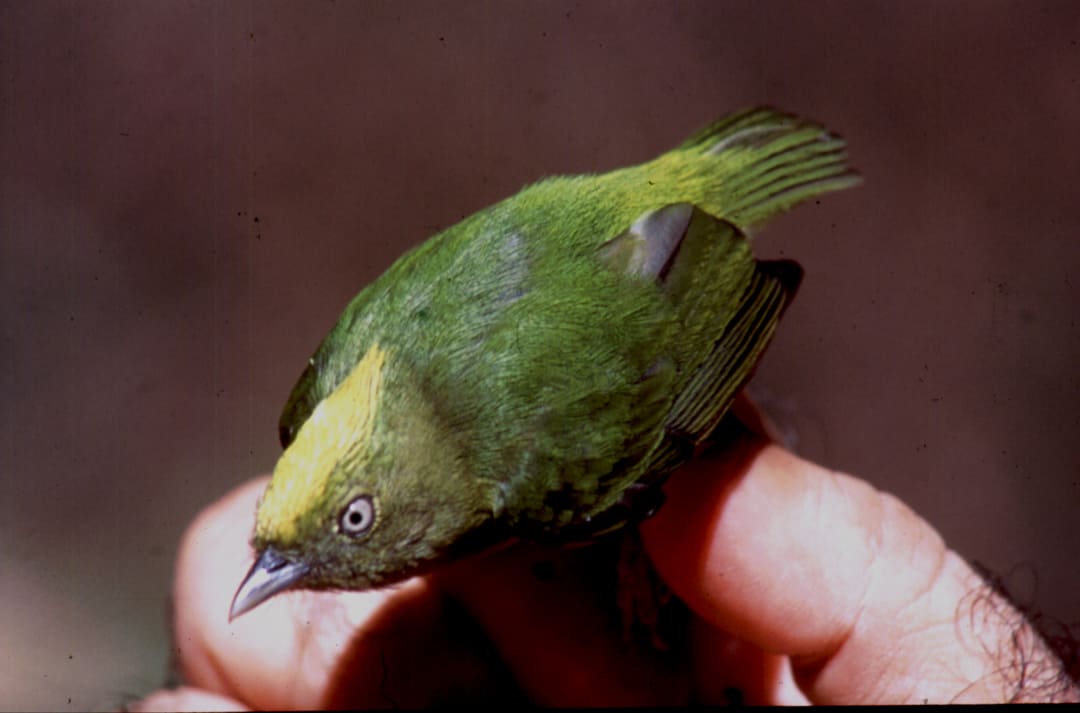Mermaids, centaurs, and sphinxes — what could be more fantastical than a mythological hybrid? Try hybrid speciation, a real but rare occurrence where a population of hybrid animals diverge from their parents to develop a new, distinct species.
A study recently published in Proceedings of the National Academy of Sciences of the United States of America revealed that a small green Amazonian bird with a head of yellow feathers, called the golden-crowned manakin, can thank hybrid speciation for its existence.
The study, led by former U of T PhD student Dr. Alfredo Barrera-Guzmán and UTSC Associate Professor Jason Weir, found that the bird originated from a population of hybrids of the opal-crowned and snow-capped manakins.
First discovered in 1957, the golden-crowned manakin eluded ornithologists for decades until it was spotted again in 2002. Despite this lack of access, it had long been suspected that the bird may have had hybrid origins.
Barrera-Guzmán and his team confirmed this hypothesis by sequencing the golden-crowned manakin’s genome. They found that 80 per cent of its DNA was derived from the opal-crowned manakin and around 20 per cent was derived from the snow-capped manakin.
“In a traditional species, you expect to see genetic differentiation,” said Barrera-Guzmán. “This species doesn’t even have its own mitochondrial DNA.” The admixed genome clearly indicated that the golden-crowned manakin was of hybrid origin.
The position of the golden-crowned manakin’s habitat ranges between those of the opal-crowned and snow-capped manakins, which suggested its relationship to the other two species.
Hundreds of thousands of years ago, periods of glaciations likely forced the opal-crowned and snow-capped manakins into contact, allowing them to occasionally interbreed and produce hybrids. Over time, the development of physical barriers like mountain ranges may have isolated a population of these hybrids and prevented them from breeding with members of their parent species. This would have reproductively isolated the populations — a prerequisite for becoming a new species.
The resemblance of the golden-crowned manakin to its parents species was also a clue, though there was one aspect of its appearance that made less sense: its colouring. Typically, hybrids have a mixture of characteristics from their parents or develop some intermediate form.
The head of the golden-crowned manakin is neither iridescent, like the head of the opal-crowned manakin, nor bright white, like that of the snow-capped — yellow does not appear to be an intermediate colour of the two.
This is partly because the colouring of the opal-crowned and snow-capped manakins is not from pigments, but it is instead a result of structural colouration. This colouration is caused by the arrangement of the microscopic keratin in the feathers.
The researchers examined the structure of the golden-crowned manakin’s feathers under a microscope and found that the actual architecture — that is, how the feathers are arranged — is an intermediate structure of the two parent species.
Still, this intermediate structure is not adept at producing intermediate colouration. Instead, the yellow comes from carotenoids in the birds’ diet. When the carotenoids are removed from the feathers, the bird is left with a rather dull colouration.
Barrera-Guzmán believes that the golden-crowned manakin likely started out with this dull colouration. He also suggested that the feathers’ hue may have to do with attracting the opposite sex.
Not only does this study confirm a decades-old hypothesis, it also has conservation implications. The golden-crowned manakin is at risk of extinction as its habitat faces pressure of deforestation. “If we lost this species, we would lose a unique result of evolution,” said Barrera-Guzmán. “By learning how hybrid species arise, maybe we can learn how to properly manage the genetic diversity.”


